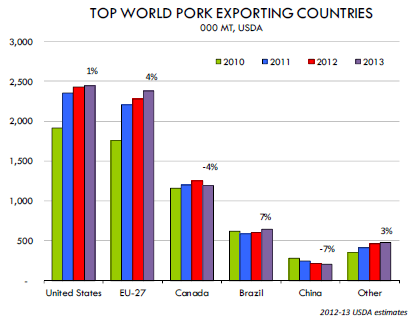



CME: US Pork Trade with China
US - Lean hog futures continued to slide on Tuesday as the nearby April contract closed down 120 points. All other contracts were down as well, write Steve Meyer and Len Steiner.Futures extended their losses overnight, with the electronic April Lean Hog contract now at $82.725/cwt, the lowest point for this contract since July of last year. Lean hog futures have dropped almost $8/cwt (-8.3 per cent) since the end of January. The decline largely reflects lower wholesale values, will almost all pork primals (belly being the exception) currently below year ago levels (see DLR 2/14). Further adding to the anxiety in the pork complex, wire services reported last night and this morning that China is preparing to require that all pork exported to that country include a third party verification that product is free of ractopamine.


According to Reuters: "China wants a third party to verify beginning 1 March that US pork shipped to the country is free of a feed additive used to promote lean muscle growth, a US Meat Export Federation spokesman told Reuters."
At this point there appears to be little clarity as to what will be the requirements for the third party verification process. China already requires that all pork that currently goes to that market be ractopamine free but the task of testing for the substance currently falls on Chinese inspectors. In the past, US product has been refused entry when trace amounts have been found.
It is difficult at this point to say what the impact of this added requirement will be on US pork trade with China. Without a clear protocol for verifying product is ractopamine free, China could potentially block entry of US product. This would be quite damaging to US pork trade in the short term as product could back up and need to be absorbed via domestic channels or other markets. It is particularly concerning that the timeline for this expected announcement is quite short, and product that is already on the water may be affected.
It is expected that an announcement about the new policy will be made by the Chinese Administration of Quality Supervision Inspection and Quarantine. Presumably at that time we will know more about the changes to the current export regime. This development in pork trade with China follows the announcement by Russia that it will stop imports of US beef and pork due to the use of ractopamine. Both the Russian demands that US pork be ractopamine free and China decision to require third party verification come despite a decision by the UN Nation’s food standards body that product is considered safe for human consumption as long as ractopamine residue levels are within specificed limits.
According to the UN commission "the ractopamine limits are set at 10 micrograms per kg of pig or cattle muscle, 40 micrograms per kg in the animals' livers and 90 micrograms per kg in their kidneys." Despite UN approval, these latest developments highlight the risks to export trade and show how vulnerable the US pork market is to non-tariff barriers. The decision by China follows a period when the Chinese domestic pork industry there is expanding.
Pork prices in China reportedly are still higher than they were back in 2009 (prior to the price spike) but have pulled back significantly since 2011 when China embarked on a short lived buying spree of US pork, making it the top market for a period of time. The potential disruptions to China trade are arguably more significant than with Russia (see chart). Combined China and Russia exports in 2012 accounted for 4 per cent of all US pork produced. For now, we wait.








